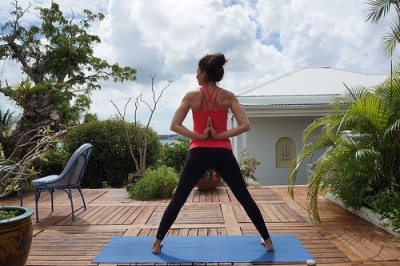
There are hundreds of muscles in the body and within muscles, there are different kinds: skeletal, smooth and cardiac. For the purposes of yoga teaching, we’re mainly concerned with skeletal muscles. But even within this one category, there are many muscles. As a yoga teacher, it can be daunting to learn them all and for many teachers, they may not learn the muscles except to generally know where they are in the body.
When we look at a muscle, there are many things we can study. When I teach anatomy, I like to focus on a few key things: the origin, the insertion and the key action. I also like to include a pose where the muscle is working or, in anatomical terms, “concentrically contracting.” This means that the muscle fibers are shortening and the insertion is moving closer to the origin. The simplest way to think of this is by looking at the action of the biceps muscle of the upper arm. The biceps, generally speaking, starts on the scapula (shoulder blade) and ends at the elbow joint. The origin, therefore is the scapula and the insertion is the elbow. When the muscle works, it flexes the arm at the elbow, thus pulling the hand closer to the face. A pose where the biceps is working to flex the elbow would be Eagle Pose.
Even within the description above, there can be even more detail provided. Concentric contractions are only one type of muscle contraction. There are also eccentric and isometric. As you can see, the study of anatomy is multi-layered and this is why once you get into it, it can quickly get overwhelming. As yoga teachers, we can choose how much detail we want to explore because in the teaching of yoga, many people focus primarily on the actions and alignment of the pose, without necessarily knowing the anatomy involved. There are some muscles though that are so commonly involved in poses and in our culture, so commonly get tight and create problems for our students, that it can be helpful to know general information about them.
Psoas: The psoas in a hip flexor. This means it draws the thigh closer to the chest, or if the leg is fixed it will bring the trunk closer to the thigh. It starts in the lower back, specifically lumbar vertebrae 1-4 and ends at the top of the thigh bone, closest to the hip joint, on a little protuberance called the lessor trochanter. When it gets tight, it will draw the tailbone back and tip the front of the pelvis down. This muscle works in Warrior 1 to flex the bent leg. If it’s tight, the person will look like they’re sticking their tailbone out. The corrective action is to lift the front of the pelvis and draw the belly in to the spine.
Serratus Anterior: This muscles is a shoulder stabilizer. It’s most commonly used when moving from High to Low Push Up. Think of it as the muscle that is activated when you draw the elbows in, close to the sides of the body as you lower down towards the floor. It starts on ribs 1-8 on the side of the body and ends on the inside edge of the shoulder blade. It’s on both sides of the body. I like to think of it as “suctioning” the shoulder blades to the back to prevent them “lifting” or “winging” off the back in Low Push Up. When that happens, the muscles of the next start to get involved and the student will struggle much more in the pose to hold it steady.
Hamstrings: These are the muscles in the back of the thigh and they give us the power to walk and run. They flex the knee as in Bridge pose and they also extend the hip. Hip extension is seen in poses like Airplane and Upward Bow. Â There are 3 parts to this muscle, but in keeping with the theme of staying high level in this discussion, let me generally say that the 3 heads start on the sitting bones, or ischial tuberosities and they end at one of the two lower leg bones, the tibia and fibula. When the hamstrings are tight, they pull on the sitting bones and forward folds or Downward Dog can be very uncomfortable. The best modification is to have the student bend the knees to relieve the stress on the muscle.
Piriformis: I included this muscle because it’s one that can really give people problems and they might not know what it is. The concept of “Piriformis Syndrome” can be painful and involves an irritation or tendinitis of the muscle and sometimes, accompanying nerve irritation due to the muscle’s proximity to the sciatic nerve. This muscle generally works to open the hip, or externally rotate it. This action happens in Tree Pose, on the bent leg, to draw the knee back and open the hip. This muscle’s origin and insertion is a little harder to explain in general terms. If you put your hand on your low back, the flat plate is your sacrum. The muscle starts on the front of the sacrum and ends on the top of the thigh bone at the greater trochanter, a protuberance on the bone where the muscle attaches.
It’s very hard to pick a few muscles to highlight because they all have important functions. However, it’s helpful to start somewhere and if you’re looking for muscles to begin to know, these are a good starting point. If you keep the above framework in mind of “origin, insertion, primary action and pose,” you can begin to make flashcards or a list to keep handy. You can refer to the internet or any number of excellent books on anatomy (Dr. Ray Long has excellent books) for the detail. I find that I always learn something new when I read about the muscles!
